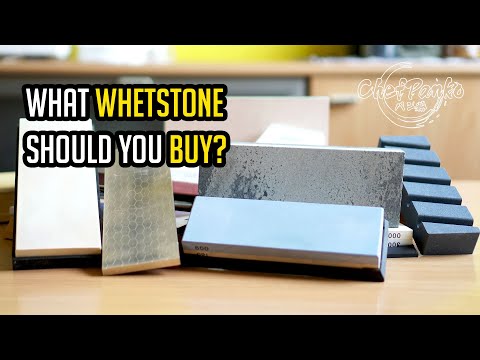
f2ace4f6139d82ad099f94dd853539aa
Sharpening stones are an essential tool for any knife enthusiast or professional chef. They are used to sharpen and hone knives, scissors, and other cutting tools. But with so many different types of sharpening stones available, it can be difficult to know which one is right for you. This guide will help you identify the best sharpening stone for your needs, so you can get the most out of your tools. We’ll discuss the different types of sharpening stones, their features, and how to choose the right one for your needs.
What does the number on a sharpening stone mean
Sharpening stones are essential tools for keeping knives, scissors, and other tools sharp. They come in a variety of shapes, sizes, and materials, and each one is labeled with a number. But what does that number mean?
The number on a sharpening stone is a grit rating. It indicates the size of the abrasive particles on the stone’s surface. The higher the number, the finer the particles and the smoother the stone. A stone with a lower number has larger particles and is more coarse. A stone with a higher number is better for honing and polishing the edge of a blade.
The most common grit ratings for sharpening stones are between 220 and 8,000. Stones with a rating of 220 are the coarsest and are used for repairing damaged edges or reshaping a blade. Stones with a rating of 8,000 are the finest and are used for honing and polishing the edge of a blade. In between these two extremes are stones with ratings of 400, 600, 1,000, 2,000, and 4,000. These are used for sharpening and honing.
When choosing a sharpening stone, it’s important to consider the type of blade you’re sharpening. A coarser stone is better for repairing a damaged edge, while a finer stone is better for honing and polishing. It’s also important to consider the type of material the stone is made of. Natural stones are usually softer and more porous than synthetic stones, so they require more frequent cleaning and lubrication.
Knowing the number on a sharpening stone can help you choose the right one for your needs. A higher number indicates a finer stone, while a lower number indicates a coarser stone. With the right sharpening stone, you can keep your blades sharp and in top condition.
Which is finer 1000 grit or 6000 grit
When it comes to sandpaper, the higher the grit number, the finer the abrasive. This means that 6000 grit is finer than 1000 grit. The difference between the two is quite significant, as 1000 grit is considered a coarse sandpaper, while 6000 grit is considered a very fine sandpaper.
1000 grit sandpaper is used for heavy sanding and removing material quickly. It is often used for removing rust, paint, and other materials from metal surfaces. It is also used for sanding down wood surfaces to prepare them for staining or painting. 1000 grit sandpaper is not suitable for finishing work, as it leaves behind a rough surface.
6000 grit sandpaper is used for finishing work. It is used to create a smooth, polished surface on wood, metal, and other materials. It is also used for polishing and buffing surfaces. 6000 grit sandpaper is not suitable for heavy sanding or removing material, as it is too fine for that purpose.
In conclusion, 6000 grit is finer than 1000 grit. 1000 grit is used for heavy sanding and removing material, while 6000 grit is used for finishing work and creating a smooth, polished surface. Both types of sandpaper have their uses, and it is important to choose the right one for the job.
How do you tell the coarse and fine side of a whetstone
Sharpening tools such as knives, scissors, and chisels require a whetstone to keep them in top condition.
Whetstones come in two different sides, a coarse side and a fine side. Knowing how to tell the difference between the two is essential for sharpening tools correctly.
Identifying the Coarse Side
The coarse side of a whetstone is usually darker in color and has a rougher texture. It is used to sharpen dull blades and remove any nicks or chips in the blade. The coarse side is also used to create a beveled edge on the blade. This is done by angling the blade against the stone and pushing it away from you.
Identifying the Fine Side
The fine side of a whetstone is usually lighter in color and has a smoother texture. It is used to refine the edge of the blade and give it a polished finish. The fine side is also used to sharpen blades that are already sharp. This is done by angling the blade against the stone and pulling it towards you.
Conclusion
Knowing how to tell the difference between the coarse and fine side of a whetstone is essential for sharpening tools correctly. The coarse side is usually darker in color and has a rougher texture, while the fine side is usually lighter in color and has a smoother texture. The coarse side is used to sharpen dull blades and create a beveled edge, while the fine side is used to refine the edge and give it a polished finish.
How do you use a sharpening stone guide
Sharpening stones are an essential tool for keeping your knives and other tools sharp. But if you’ve never used one before, it can be difficult to know where to start. That’s why a sharpening stone guide is so important. With the right guide, you can learn how to use a sharpening stone correctly and get the most out of it.
Steps for Using a Sharpening Stone Guide
Using a sharpening stone guide is easy. Here are the steps you should follow:
- Choose the right stone. Different stones are designed for different purposes, so make sure you choose the right one for your needs. A guide can help you decide which stone is best for you.
- Prepare the stone. Before you start sharpening, you need to prepare the stone. This includes soaking it in water and flattening it if necessary.
- Choose the right angle. The angle you use when sharpening is important. A guide can help you determine the right angle for your stone.
- Start sharpening. Once you’ve chosen the right angle, you can start sharpening. Move the blade across the stone in a consistent motion.
- Check your progress. As you sharpen, check your progress to make sure you’re getting the desired results.
- Clean the stone. When you’re done sharpening, clean the stone with water and a brush.
Benefits of Using a Sharpening Stone Guide
Using a sharpening stone guide has many benefits. It can help you choose the right stone for your needs, learn the correct angle for sharpening, and get the best results. It can also help you save time and money by avoiding costly mistakes. With the right guide, you can get the most out of your sharpening stone.
We hope this guide has been helpful in identifying your sharpening stone. We wish you the best of luck in your sharpening endeavors! Goodbye and take care!
















